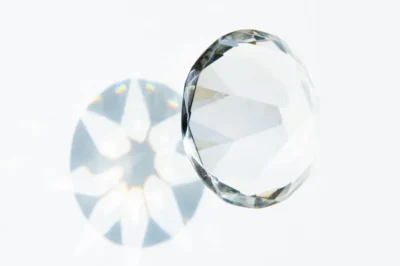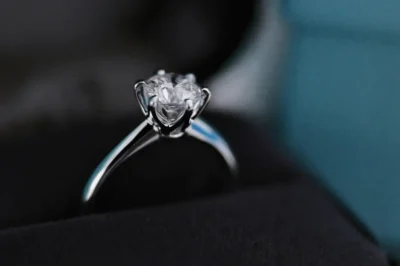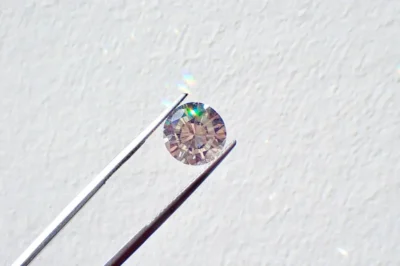TAKEAWAYS
Moissanite and lab-grown diamonds are visually similar but differ in key properties like hardness, sparkle, color, and price.
Moissanite is slightly softer, has more rainbow-like fire, and is more affordable, while lab-grown diamonds are harder, have classic brilliance, and are chemically identical to natural diamonds.
To distinguish them:
- Use a Moissanite tester or diamond tester carefully
- Examine under magnification for double refraction
- Observe sparkle, fog response, and weight differences
- Seek professional gemologist appraisal if unsure
Understanding these differences helps buyers make informed jewelry choices.
When shopping for jewelry—especially engagement rings—one of the trickiest challenges is figuring out what you’re actually buying. Two stones that often get confused are Moissanite and lab-grown diamonds. Both are sparkling, beautiful, and durable, yet they have subtle differences that make them unique. Understanding these differences is essential for buyers who want to make informed decisions. In this article, we’ll explore how to tell Moissanite apart from lab-grown diamonds, why it matters, and what you should look for before making a purchase.
Whether you’re a seasoned diamond collector, a first-time engagement ring buyer, or just curious about gemstones, this guide will help you navigate the dazzling world of Moissanite and lab-grown diamonds with confidence.
What Are Moissanite and Lab-Grown Diamonds?
Before diving into the differences, it’s essential to understand what each of these stones is and where they come from.
Understanding Moissanite
Moissanite is a gemstone that was first discovered in a meteor crater by Nobel Prize-winning chemist Dr. Henri Moissan in 1893. True natural Moissanite is extremely rare—so rare that almost all Moissanite sold today is lab-created.
Key properties of Moissanite include:
- Hardness: 9.25 on the Mohs scale, making it very durable but slightly softer than diamonds.
- Brilliance: Moissanite is known for its extraordinary sparkle, often described as having a “rainbow-like” fire that is more intense than diamonds.
- Color: High-quality Moissanite is typically colorless, but some may have faint yellow or gray tints.
Moissanite’s dazzling sparkle, durability, and ethical production have made it an increasingly popular choice for engagement rings and fine jewelry.
Understanding Lab-Grown Diamonds
Lab-grown diamonds, as the name suggests, are diamonds created in laboratories rather than mined from the Earth. Modern technology allows us to produce diamonds that are chemically, physically, and optically identical to natural diamonds.
Key properties of lab-grown diamonds include:
- Hardness: A perfect 10 on the Mohs scale.
- Brilliance: Diamonds have classic brilliance, which is slightly different from Moissanite’s fire.
- Color and clarity: Lab-grown diamonds come in a range of colors and clarity grades, similar to mined diamonds.
Lab-grown diamonds have gained popularity due to their ethical production, more affordable pricing, and ability to offer larger stones for the same budget compared to mined diamonds.
Key Differences Between Moissanite and Lab-Grown Diamonds
Now that we understand what each stone is, it’s time to explore the key differences that help distinguish Moissanite from lab-grown diamonds.
Hardness and Durability
One of the easiest ways to differentiate Moissanite from a lab-grown diamond is by their hardness.
- Moissanite: 9.25 on the Mohs scale. It’s very hard and suitable for everyday wear, but it is slightly more prone to scratches than diamonds.
- Lab-Grown Diamonds: 10 on the Mohs scale, making them the hardest known natural or lab-created material.
In practical terms, both stones are durable enough for engagement rings and other jewelry, but if extreme hardness is your top priority, diamonds have a slight edge.
Sparkle and Fire
Moissanite is famous for its fiery sparkle. It bends light more intensely than diamonds, which can result in rainbow-like flashes, especially in bright sunlight or LED lighting.
Lab-grown diamonds, on the other hand, have more subtle brilliance. Their sparkle is more white and sparkling rather than rainbow-like.
If you notice a stone that seems to flash a lot of rainbow colors under light, it’s more likely to be Moissanite than a diamond.
Color and Clarity
Moissanite is generally near-colorless, but some stones can have faint yellow or gray undertones, especially in larger sizes. Lab-grown diamonds, meanwhile, are graded in the same way as mined diamonds—from D (colorless) to Z (light yellow).
In terms of clarity, both stones can be nearly flawless, but Moissanite typically has fewer inclusions because it is manufactured under controlled conditions.
Price Differences
Price is a major differentiator for most buyers. Moissanite is generally 20–30% the cost of a similar-sized lab-grown diamond.
Factors affecting price include:
- Stone size and carat weight
- Cut quality
- Color and clarity
Because of this price difference, Moissanite is often considered an affordable alternative to diamonds without sacrificing sparkle or beauty.
How to Test If a Stone is Moissanite or Lab-Grown Diamond
For buyers who want to be certain, several testing methods can help differentiate Moissanite from lab-grown diamonds.
Using a Diamond Tester
Diamond testers are devices that measure thermal conductivity. Diamonds conduct heat differently than most other gemstones. However, Moissanite conducts heat in a way that can sometimes fool a standard tester.
Tip: If a diamond tester indicates a positive result, it could be a diamond—or it could be Moissanite.
Using a Moissanite Tester
To accurately identify Moissanite, you may need a Moissanite-specific tester, which uses electrical conductivity rather than thermal conductivity. These testers can reliably distinguish between diamonds and Moissanite.
Magnification Techniques
A jeweler’s loupe or microscope can help spot double refraction, a hallmark of Moissanite. Under magnification, you may see doubled facets or lines inside the stone, which diamonds do not have.
Professional Gemologist Appraisal
When in doubt, take your stone to a certified gemologist. They can perform advanced tests and provide a grading report, often from GIA or IGI, confirming whether the stone is Moissanite or a lab-grown diamond.
Visual Clues for Everyday Buyers
If you don’t have access to testers, you can still rely on visual cues.
Sparkle Test in Different Lights
Look at your stone under various lighting conditions.
- Moissanite tends to flash rainbow colors.
- Diamonds tend to sparkle with more white light and subtle fire.
Fog Test
Breathe on the stone to see how it reacts to condensation.
- Diamonds tend to clear quickly.
- Moissanite may stay fogged slightly longer due to its different thermal properties.
Weight and Feel
Moissanite is slightly less dense than diamonds, so stones of the same size may feel a little lighter. This is a subtle difference, but for larger stones, it may be noticeable to a trained eye.
Common Misconceptions
There are several myths surrounding Moissanite and lab-grown diamonds that can confuse buyers.
“Moissanite is a Fake Diamond”
Moissanite is not a fake diamond—it’s a unique gemstone with its own properties and beauty. While it is often compared to diamonds, it deserves recognition in its own right.
Lab-Grown Diamonds Are Less Valuable
While lab-grown diamonds are often cheaper than mined diamonds, they are still true diamonds. Their chemical, optical, and physical properties are identical to natural diamonds.
Clearing up these misconceptions helps buyers make more informed decisions and appreciate each stone’s unique qualities.
Choosing Between Moissanite and Lab-Grown Diamonds
So, how do you choose between these two sparkling stones?
Factors to Consider
- Budget: Moissanite is much more affordable.
- Durability: Diamonds are harder, but Moissanite is still very durable.
- Sparkle Preference: Moissanite has more rainbow fire; diamonds have classic sparkle.
- Ethics: Both are ethically produced, but lab-grown diamonds are often marketed as “conflict-free.”
Making the Right Choice for Engagement Rings
Engagement rings are meant to be worn daily, so durability, sparkle, and budget all play a role. If you want a statement stone with intense fire and lower cost, Moissanite is a great choice. If you want a traditional diamond look with timeless appeal, lab-grown diamonds may be ideal.
Conclusion
Knowing how to tell Moissanite apart from lab-grown diamonds can save you from costly mistakes and help you choose a stone you’ll love for a lifetime. By understanding differences in hardness, sparkle, color, and price, along with testing methods, visual cues, and professional appraisal, you can confidently select the gemstone that fits your lifestyle, budget, and personal taste.
Whether you’re drawn to the fiery brilliance of Moissanite or the classic allure of lab-grown diamonds, both options offer stunning beauty and lasting value. With this knowledge, you’re now equipped to make a smart, informed decision—no guesswork required.






